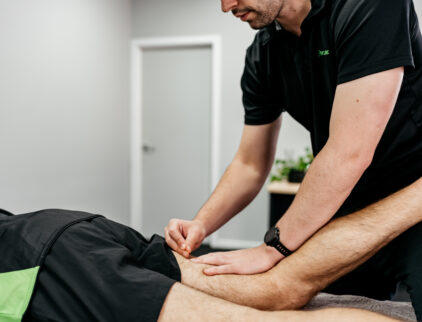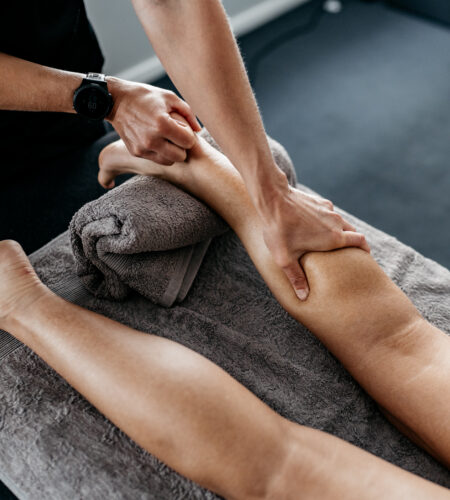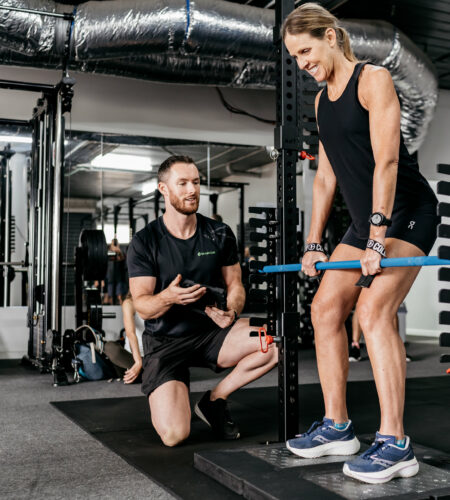
Want to learn more about Dry Needling?
Sam Lewis, Physiotherapist, has answered some questions on this topic!
Check them out below!



What is Dry Needling?
Dry needling is a therapy technique that involves using a fine filament needle – the same as those used in acupuncture – to elicit a local twitch response from a muscle. This approach is most commonly used to address the health and function of muscle tissue.
When Dry Needling we utilise the needle to target myofascial trigger points, or tight spots often referred to as ‘knots’ in the muscle.
Myofascial trigger points are very common, and can result in symptoms in motor function including muscle spasm, weakness, loss of coordination and decreased work tolerance. These often occur as the result of muscle overload.
How does dry needling help?
As we previously outlined, the aim of dry needling is to create a local twitch response (LTR).
By eliciting a local twitch response we aim to treat the symptoms associated with muscular overload and improve the length, strength and fatigability of a muscle. In doing so we aim to improve muscle and joint function.
If we use the analogy of our computer. Sometimes when our computer isn’t working we will hold the power button and reset the computer. When we dry needling and create a LTR we are aiming to ‘reset’ or restore our muscle to its original function.
Should I get dry needling before my event?
Dry needling can be beneficial prior to an event to game day to improve performance if you have been experiencing myofascial symptoms associated with muscle overload. However, it is very important to consider how each individual responds to needling. Everyone is different and it can be expected that not everyone will react the same to needling. It is common for clients to often feel achy and experience muscle soreness post needling whereas some people will feel significant improvements immediately post needling and will not feel as achey.
Thus, when dry needling prior to an event it is important to consider if we have had needling before and if we have it in the same muscle or area before and ultimately how we responded to needling. This ultimately will help guide our decision to determine if we will do dry needling prior to an event and if so when we will do it prior to an event.
I’m scared of needles! Do I need dry needling?
Whilst at the clinic we understand the benefits of dry needling and how we can use it as a form of treatment and therapy we also appreciate that not everyone is suitable to dry needling and not everyone will want dry needling. The physiotherapists at the clinic will never force or complete dry needling on a client that does not feel comfortable or is unsure whether they want dry needling or not.
When we do think that dry needling would be an appropriate treatment, we make sure to educate the client on why we think dry needling would be beneficial, we explain to them the process of dry needling, and the common symptoms associated with needling and ultimately attain informed consent.
If dry needling was suggested or offered as a therapy or treatment but you do not feel comfortable, that does not mean you will not receive any treatment. Dry Needling is used in conjunction with other treatment techniques so if you do not want dry needling, you will still have access to a variety of other high quality forms of treatment from your Physio!
Does Dry Needling hurt?
As outlined above, each person can respond differently to dry needling. When being needled it may be common to experience an achy sensation as a LTR is achieved. Post treatment is is also common to experience
- Muscle Soreness: the muscle needled may feel tender, bruised, tight or heavy – again some clients may not experience these symptoms whilst others may experience them lasting up to two days post treatment.
- Fatigue/drowsiness: some people may feel drowsy post needling – this can be influenced by the volume of needling, the muscle being needled and the type of injury. Again not everyone may experience this!
- Bruising: Post needling it is not uncommon for clients to experience small bruises – these usually settle quickly and do not hurt moving forward.
Link to more information on dry needling at TIC:
https://www.theinjuryclinic.com.au/physio-geelong/dry-needling/
Schedule your next visit
If you’re interested in booking an appointment with one of our team members, contact our clinic today and we’ll be happy to find time for a consultation.
Schedule ConsultExplore our physiotherapy services
Musculoskeletal
Physiotherapy
At The Injury Clinic Physiotherapy, we work closely with our clients to get them back doing the things they love as soon as possible.
Sports
Physiotherapy
The Injury Clinic Physiotherapy works with recreational to elite athletes to keep them injury free and achieving their goals.
Dry
Needling
All physiotherapists at The Injury Clinic Physiotherapy are qualified and experienced in dry needling as a treatment technique.
Running Related Injuries
Physiotherapists at The Injury Clinic Physiotherapy have a special interest in the diagnosis and management of running-related injuries.
Women's Health
Physiotherapy
We have physiotherapists with a special interest in Women's Health, including pre and post partum presentations. Let us work with you to stay fit, active and healthy.
Pre & Post-Operative
Physiotherapy
Physiotherapists at The Injury Clinic Physiotherapy work closely with surgeons to ensure best outcomes post surgery.
Injury Q&A
Our clinicians have been answering all your questions!
Running Analysis
The goal of a running analysis is to identify aspects of your technique that may be contributing to injury or impacting on efficiency.






Schedule your next visit
If you’re interested in booking an appointment with one of our team members, contact our clinic today and we’ll be happy to find time for a consultation.
Schedule Consult